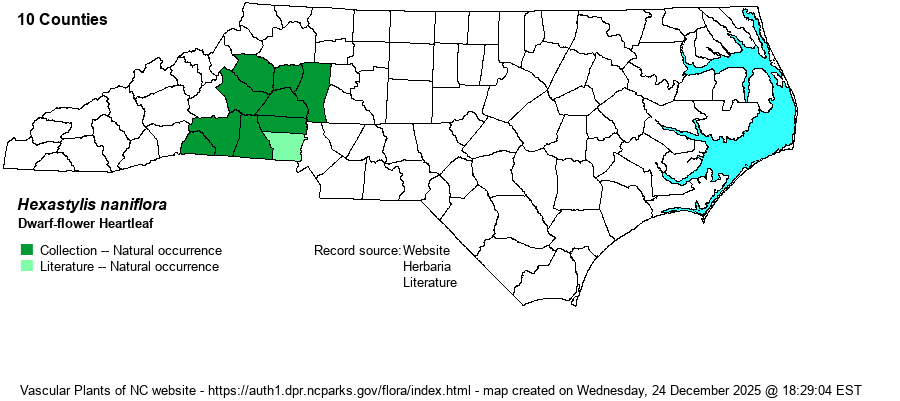| Author | Blomquist | |
| Distribution | A tight range in the southwestern quarter of the Piedmont, not quite extending into the Mountains. There are records eastward to Iredell and Gaston counties.
This species is endemic to just southwestern NC and adjacent northwestern SC, but limited to the upper Piedmont in each state. | |
| Abundance | Formerly thought to be rare (it is Federally listed as Threatened and thus also State Threatened), but recent detailed surveys have uncovered many dozens of populations. Thus, it is generally uncommon over this region, but rare as far east as Iredell and Gaston counties. It has a State Rank of S3, with a corresponding Global Rank also of G3. Because a fairly large number of populations are now known, it has been proposed for removal from Federal listing. Delisting will be effective on 7 August 2025. | |
| Habitat | This is a species of acidic sandy loam on dry to mesic slopes and bluffs, generally under or next to Mountain Laurel (Kalmia latifolia). It may grow along wooded creek banks, but generally where rocky or steep nearby. This is a very similar habitat for that of other Hexastylis species, and thus habitat does not segregate out this species from others with the same range. | |
| Phenology | Blooms from March into June, and fruits soon after flowering. | |
| Identification | This species, when in leaf, simply cannot be conclusively identified, much to the chagrin of people surveying for populations of this Fedderally listed species. It has the standard several leaves from a basal stem, each leaf being somewhat smaller than most other species, often only 2 inches across and wide, but still not safely identified by leaf alone. The leaves are rounded, thick, glossy, dark green and evergreen, with a cordate base; most or all leaves are variegated with white or pale green along the veins. The several flowers at the bases of the leaves also are smaller than all others in the genus, being cylindrical in shape, but only about 1 cm (2/5-inch) long, with the opening of the calyx tube only about 7-8 mm (1/3-inch) wide, narrow enough that you cannot put your "pinkie" into the opening of the calyx tube (i.e., it fails the "Pinkie Test"). Also, the calyx lobes are barely 1/8-inch long, but are spreading and not erect. Other variegated heartleaf species in the area have larger flowers with notably larger openings such that you can fit your pinkie into the calyx. Hexastylis virginica can be quite similar, but it has a flower cup typically over 2/5-inch long, usually around 1/2-inch long, and it normally has leaves closer to 3 inches across. Its calyx lobes are short, as with H. naniflora, but those lobes are erect or ascending and not spreading as in H. naniflora. You do have a decent chance of finding the species on your own by hiking along creeks and ravines in the southwestern Piedmont, though it is highly likely it will have already been discovered by biologists beforehand. | |
| Taxonomic Comments | None
| |
| Other Common Name(s) | None, other than modified forms of the same name, such as Dwarf-flowered Heartleaf | |
| State Rank | S3 | |
| Global Rank | G3 | |
| State Status | T | |
| US Status | LT | |
| USACE-agcp | | |
| USACE-emp | | |

